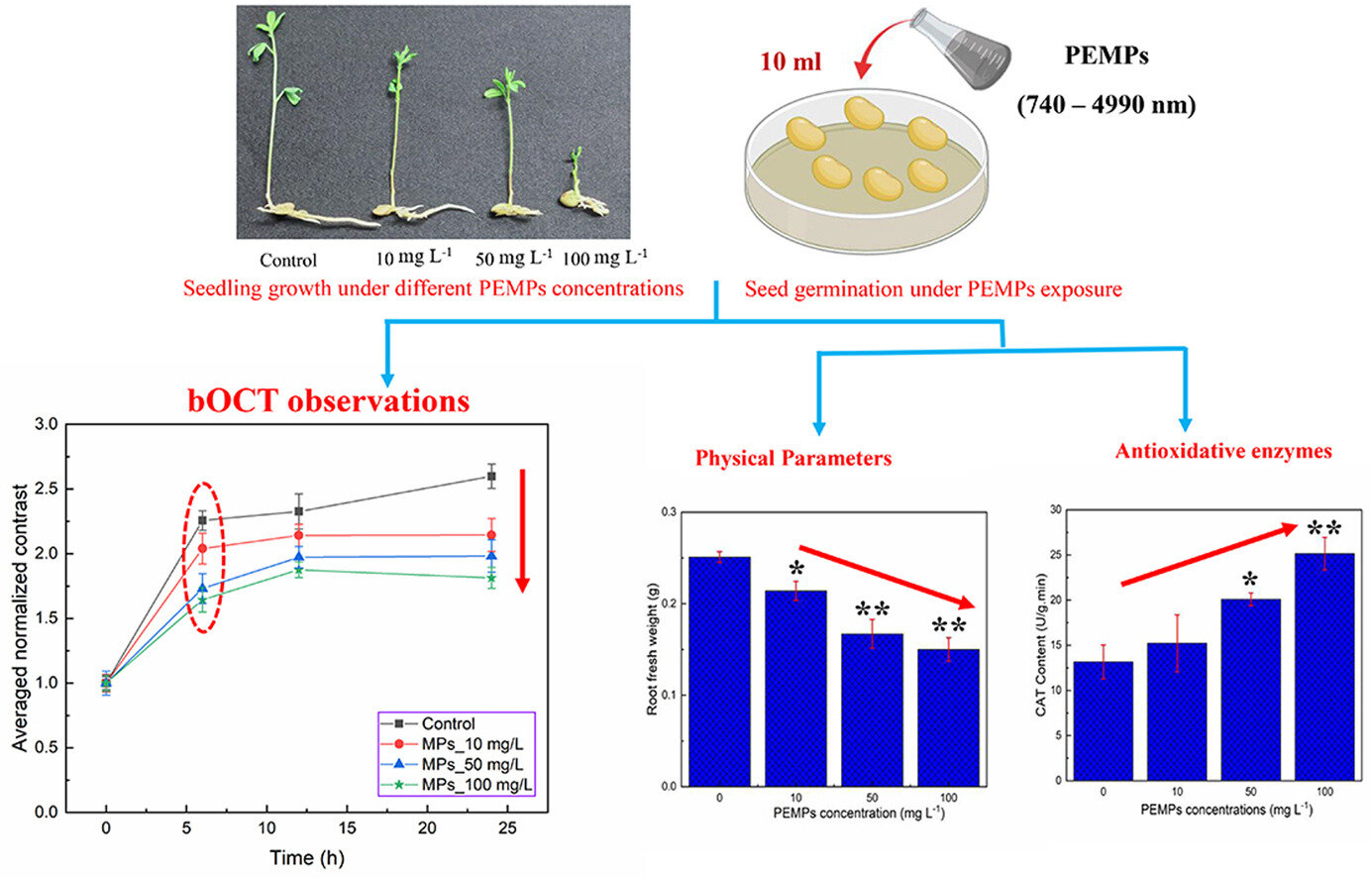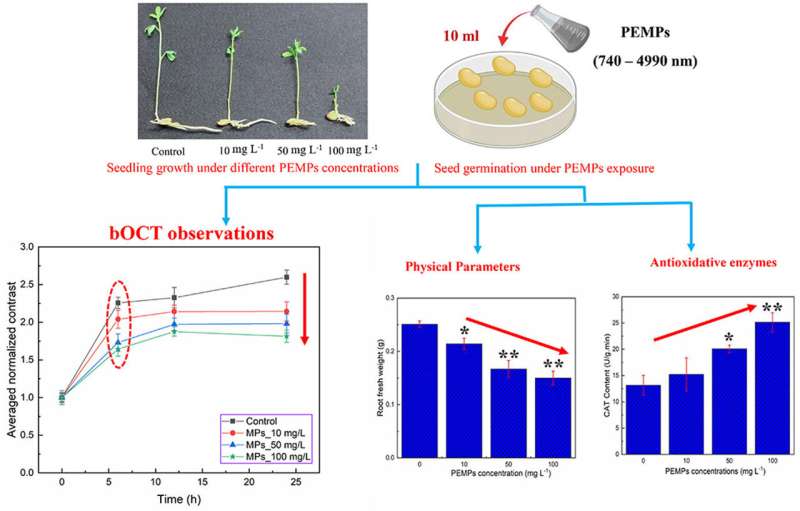

Microplastic pollution is known to negatively impact seed germination and seedling growth. Although some studies have demonstrated the effects of microplastics on seed germination, the impact of microplastics on the internal biological activity of seeds remained unknown. Now, a group of researchers has used biospeckle optical coherence tomography to reveal that microplastics significantly hinder the internal activity in lentil seeds during germination and can lead to stunted growth at later stages.
Microplastics are small fragments of plastic, less than 5 mm in diameter. There are two types of microplastics: primary and secondary. Any plastic particles that are already 5 mm in size or smaller before entering the environment are considered primary microplastics. They exist in cosmetics, textiles, scrubbing agents, and toiletries. On the other hand, secondary microplastics are formed when bigger plastic products such as bottles, containers, fishing nets, the plastic mulch used for agriculture, and plastic bags break down into smaller pieces due to natural weathering processes.
In recent decades, microplastic pollution has become a major cause of concern worldwide. Owing to their increased use and a lack of proper waste management, microplastics are accumulating in ecosystems at an alarming rate, posing a severe threat to plants, animals, and humans alike.
Much like human bodies, plants have a method of transporting nutrients picked up by their roots to other parts of their bodies. Developing plants can absorb microplastics through cracks in their young roots. These may then travel along the xylem (which forms a part of the plant’s “distribution system”) to the edible parts of the plant. Recently, microplastics have been found in many common fruits and vegetables and even in table salt.
As we understand how microplastics could get distributed through the food chain, an important question arises: How do these microplastics affect the very plants that absorb them? A team of researchers sought to investigate this starting with the earliest stage of a plant’s life–seed germination.
The team, comprising Prof. Uma Maheswari Rajagopalan of Shibaura Institute of Technology (SIT), and Prof. Hirofumi Kadono along with his Ph.D. students, Y. Sanath K. De Silva and Li Danyang of Saitama University, Japan, investigated the effects of microplastics on lentil seed germination and seedling growth, focusing on how these pollutants impact a seed’s internal activity. They used biospeckle optical coherence tomography (bOCT)—a technique that they had proposed and then proven to accurately demonstrate the internal activity of plants—to carry out their observations, the details of which were published in the journal Chemosphere.
The researchers exposed lentil seeds to different concentrations of polyethylene microplastics (PEMPs) for seven days, with bOCT observations being noted at 0, 6, 12, and 24 hours. The findings of bOCT were then compared to biological parameters of germination and growth, as well as antioxidative enzyme activity.
Their findings were quite promising. After just 6 hours, bOCT data demonstrated that the seeds treated with PEMPs had a substantial decrease in internal activity, proving the detrimental effects of microplastics on their germination and subsequent plant growth. An increase in antioxidative enzyme activities was observed as well. The study noted that when the PEMP concentration was raised, the drop in internal activity was more pronounced, suggesting a dose-dependent effect of PEMPs on lentil seeds and seedlings.
“Our findings showed, for the first time, that microplastics impede the internal activity of seeds during germination. This is likely due to the physical blockage of pores, which leads to stunted growth at later stages,” says Prof. Rajagopalan.
Indeed, their unique approach of modifying OCT, a technique used extensively in the field of ophthalmology, to biospeckle OCT—which utilizes the noise appearing in an OCT to its advantage—proved very effective. Conventional methods, which rely on lengths and weights, take about two days of exposure to show similar results, a feat bOCT achieved within hours.
The technique can be used to effectively observe the dose-dependent effects of microplastics on seeds. “Our results highlight the potential of bOCT as a screening tool for a speedy assessment of seed quality and environmental pollution,” says Prof. Rajagopalan.
In conclusion, this study shows that PEMPs negatively impact the germination of lentil seeds that, in turn, affects their growth. This result has important implications for policymaking in relation to the control and management of microplastic pollution.
Microplastics threaten typical remote cryospheric regions
Y. Sanath K. De Silva et al, Effects of microplastics on lentil (Lens culinaris) seed germination and seedling growth, Chemosphere (2022). DOI: 10.1016/j.chemosphere.2022.135162
Provided by
Shibaura Institute of Technology
Citation:
Shedding light on the impact of microplastics on lentil seedling growth (2022, June 23)
retrieved 23 June 2022
from https://phys.org/news/2022-06-impact-microplastics-lentil-seedling-growth.html
This document is subject to copyright. Apart from any fair dealing for the purpose of private study or research, no
part may be reproduced without the written permission. The content is provided for information purposes only.

